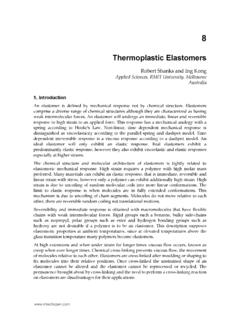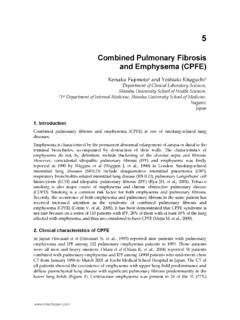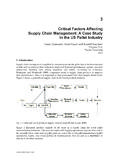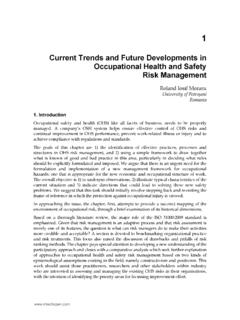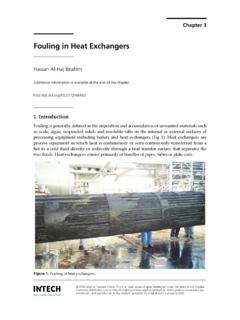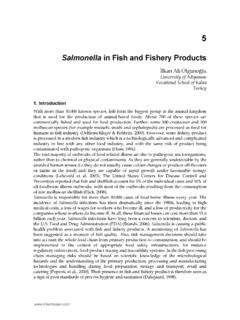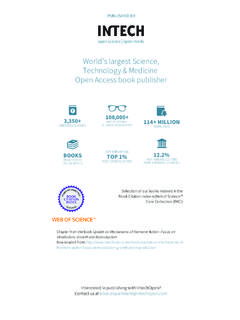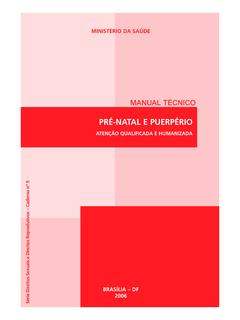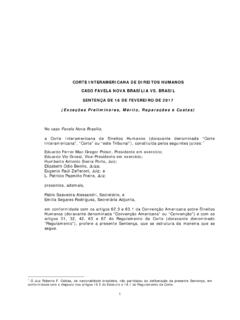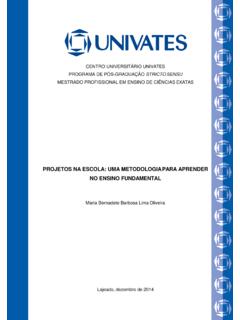Transcription of Textile Dyes: Dyeing Process and Environmental Impact
1 Chapter 6 Textile Dyes: Dyeing Process and Environmental ImpactFarah Maria Drumond Chequer,Gisele Augusto Rodrigues de oliveira ,Elisa Raquel Anast cio Ferraz,Juliano Carvalho Cardoso,Maria Valnice Boldrin Zanoni andDanielle Palma de OliveiraAdditional information is available at the end of the IntroductionDyes may be defined as substances that, when applied to a substrate provide color by aprocess that alters, at least temporarily, any crystal structure of the colored substances [1,2].Such substances with considerable coloring capacity are widely employed in the Textile ,pharmaceutical, food, cosmetics, plastics, photographic and paper industries [3,4]. The dyescan adhere to compatible surfaces by solution, by forming covalent bond or complexes withsalts or metals, by physical adsorption or by mechanical retention [1,2]. Dyes are classifiedaccording to their application and chemical structure, and are composed of a group of atomsknown as chromophores, responsible for the dye color.
2 These chromophore-containing cen ters are based on diverse functional groups, such as azo, anthraquinone, methine, nitro, aril methane, carbonyl and others. In addition, electrons withdrawing or donating substituentsso as to generate or intensify the color of the chromophores are denominated as auxo chromes. The most common auxochromes are amine, carboxyl, sulfonate and hydroxyl [5-7].It is estimated that over 10,000 different dyes and pigments are used industrially and over 7x 105 tons of synthetic dyes are annually produced worldwide [3,8,9]. Textile materials canbe dyed using batch, continuous or semi-continuous processes. The kind of Process used de pends on many characteristics including type of material as such fiber, yarn, fabric, fabric 2013 Chequer et al.; licensee InTech. This is an open access article distributed under the terms of theCreative Commons Attribution License ( ), which permitsunrestricted use, distribution, and reproduction in any medium, provided the original work is properly and garment, as also the generic type of fiber, size of dye lots and quality re quirements in the dyed fabric.
3 Among these processes, the batch Process is the most com mon method used to dye Textile materials [10].In the Textile industry, up to 200,000 tons of these dyes are lost to effluents every year duringthe Dyeing and finishing operations, due to the inefficiency of the Dyeing Process [9]. Un fortunately, most of these dyes escape conventional wastewater treatment processes andpersist in the environment as a result of their high stability to light, temperature, water, de tergents, chemicals, soap and other parameters such as bleach and perspiration [11]. In addi tion, anti-microbial agents resistant to biological degradation are frequently used in themanufacture of textiles, particularly for natural fibers such as cotton [11,12]. The syntheticorigin and complex aromatic structure of these agents make them more recalcitrant to biode gradation [13,14]. However, Environmental legislation obliges industries to eliminate colorfrom their dye-containing effluents, before disposal into water bodies [9,12].
4 The Textile industry consumes a substantial amount of water in its manufacturing processesused mainly in the Dyeing and finishing operations of the plants. The wastewater from tex tile plants is classified as the most polluting of all the industrial sectors, considering the vol ume generated as well as the effluent composition [15-17]. In addition, the increaseddemand for Textile products and the proportional increase in their production, and the useof synthetic dyes have together contributed to dye wastewater becoming one of the substan tial sources of severe pollution problems in current times [6,9]. Textile wastewaters are characterized by extreme fluctuations in many parameters such aschemical oxygen demand (COD), biochemical oxygen demand (BOD), pH, color and salini ty. The composition of the wastewater will depend on the different organic-based com pounds, chemicals and dyes used in the dry and wet-processing steps [6,18].
5 Recalcitrantorganic, colored, toxicant, surfactant and chlorinated compounds and salts are the main pol lutants in Textile effluents [17].In addition, the effects caused by other pollutants in Textile wastewater, and the presence ofvery small amounts of dyes (<1 mg/L for some dyes) in the water, which are neverthelesshighly visible, seriously affects the aesthetic quality and transparency of water bodies suchas lakes, rivers and others, leading to damage to the aquatic environment [19,20].During the Dyeing Process it has been estimated that the losses of colorants to the environ ment can reach 10 50% [13,14,17,21,22]. It is noteworthy that some dyes are highly toxic andmutagenic, and also decrease light penetration and photosynthetic activity, causing oxygendeficiency and limiting downstream beneficial uses such as recreation, drinking water andirrigation [13,14,23]With respect to the number and production volumes, azo dyes are the largest group of colo rants, constituting 60-70% of all organic dyes produced in the world [2,24].
6 The success ofazo dyes is due to the their ease and cost effectiveness for synthesis as compared to naturaldyes, and also their great structural diversity, high molar extinction coefficient, and medi um-to-high fastness properties in relation to light as well as to wetness [2,25]. They have awide range of applications in the Textile , pharmaceutical and cosmetic industries, and are al Eco-Friendly Textile Dyeing and Finishing152so used in food, paper, leather and paints [26,27]. However, some azo dyes can show toxiceffects, especially carcinogenic and mutagenic events [27,28].The toxic effects of the azo dyes may result from the direct action of the agent itself or of thearyl amine derivatives generated during reductive biotransformation of the azo bond [22].The azo dyes entering the body by ingestion can be metabolized to aromatic amines by theazoreductases of intestinal microorganisms. If the dyes are nitro, they can be metabolized bythe nitroredutases produced by the same microorganisms [29].
7 Mammalian liver enzymesand other organizations may also catalyze the reductive cleavage of the azo bond and thenitroreduction of the nitro group. In both cases, if N-hydroxylamines are formed, these com pounds are capable of causing DNA damage [29, 30].One of the most difficult tasks confronted by the wastewater treatment plants of Textile in dustries is the removal of the color of these compounds, mainly because dyes and pigmentsare designed to resist biodegradation, such that they remain in the environment for a longperiod of time. For example, the half-life of the hydrolyzed dye Reactive Blue 19 is about 46years at pH 7 and 25 C [31,32].Carneiro et al. (2010) designed and optimized an accurate and sensitive analytical meth od for monitoring the dyes Disperse Blue 373 (DB373), Disperse Orange 37(DO37) and Disperse Violet 93 (DV93) in Environmental samples. This investigationshowed that DB373, DO37 and DV93 were present in both untreated river water anddrinking water, indicating that the effluent treatment (pre-chlorination, flocculation, coag ulation and flotation) generally used by drinking water treatment plants, was not entire ly effective in removing these dyes.
8 This study was confirmed by the mutagenic activitydetected in these wastewaters [33].In this context, and considering the importance of colored products in present day societies,it is of relevance to optimize the coloring Process with the objective of reducing the environ mental Impact of the Textile industry. For this purpose, liposomes could be used to carryseveral encapsulated dyes, and hence improve the mechanical properties of Textile products,resulting in better wash fastness properties and reducing the Process temperature, thuseconomizing energy [34]. Another way is to use ultrasonic energy, studied with the objec tives of improving dye productivity and washing fastness, and reducing both energy costsand water consumption [35].Considering the fact that the Textile Dyeing Process is recognized as one of the most environ mentally unfriendly industrial processes, it is of extreme importance to understand the criti cal points of the Dyeing Process so as to find alternative, eco-friendly Dyeing processThe Dyeing Process is one of the key factors in the successful trading of Textile products.
9 Inaddition to the design and beautiful color, the consumer usually looks for some basic prod uct characteristics, such as good fixation with respect to light, perspiration and washing, Textile Dyes: Dyeing Process and Environmental initially and after prolonged use. To ensure these properties, the substances that givecolor to the fiber must show high affinity, uniform color, resistance to fading, and be eco nomically feasible [36].Modern Dyeing technology consists of several steps selected according to the nature of thefiber and properties of the dyes and pigments for use in fabrics, such as chemical structure,classification, commercial availability, fixing properties compatible with the target materialto be dyed, economic considerations and many others [36]. Dyeing methods have not changed much with time. Basically water is used to clean, dyeand apply auxiliary chemicals to the fabrics, and also to rinse the treated fibers or fabrics[37].
10 The Dyeing Process involves three steps: preparation, Dyeing and finishing, as follows:Preparation is the step in which unwanted impurities are removed from the fabrics beforedyeing. This can be carried out by cleaning with aqueous alkaline substances and detergentsor by applying enzymes. Many fabrics are bleached with hydrogen peroxide or chlorine-containing compounds in order to remove their natural color, and if the fabric is to be soldwhite and not dyed, optical brightening agents are added [37]. Dyeing is the aqueous application of color to the Textile substrates, mainly using syntheticorganic dyes and frequently at elevated temperatures and pressures in some of the steps[37,38]. It is important to point out that there is no dye which dyes all existing fibers and nofiber which can be dyed by all known dyes [39]. During this step, the dyes and chemical aidssuch as surfactants, acids, alkali/bases, electrolytes, carriers, leveling agents, promotingagents, chelating agents, emulsifying oils, softening agents etc [23,38] are applied to the tex tile to get a uniform depth of color with the color fastness properties suitable for the end useof the fabric [37].


